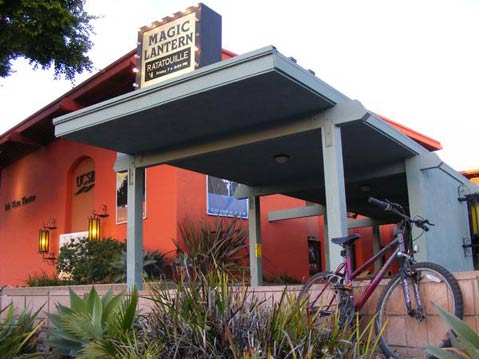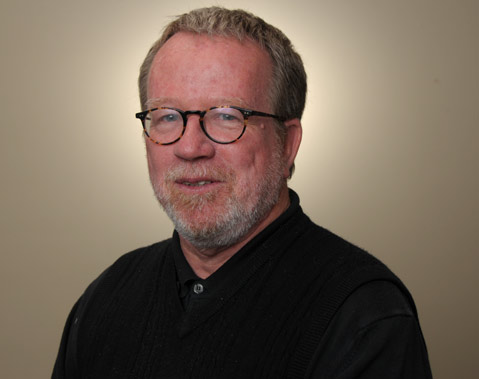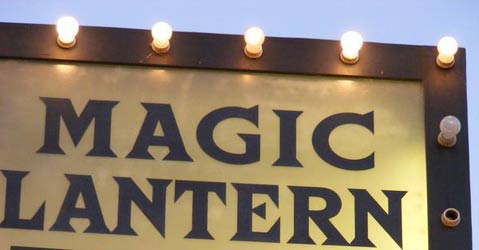
“Look at that crowd!,” exclaimed D.J. Palladino in response to the hoards of students who crowded into Isla Vista Theater late on a Monday night in November to catch District 9. Palladino heads Magic Lantern, the UCSB-affiliated program that brought District 9 (and a multitude of other films) to I.V. Theater (for only $4!) in the first place. To see crowds gather at the bi-weekly screenings is something truly magical for Palladino.
He has headed the current incarnation of Magic Lantern for five of the program’s six years of existence, after Christy Julin and Christ Zwicke, of the UCSB Film Studies Department, brought the program to I.V. Theater as seniors in 2004. (Joe Palladino, DJ’s brother, has been an advisor for the department for seven years.) To speak of Palladino’s relationship with Magic Lantern as a recent fixation would be false: it’s as established as his interest in films and entertainment.
When the theater was first built in 1965, the building functioned as a place for art house cinema. “It was a very, very culturally important place to people my age and to baby boomers, when we were young,” he explained. “We came to the movies here all the time.”

Palladino moved from Los Angeles to Santa Barbara with his family when he was 17. He went on to enroll at UCSB because Santa Barbara was “so much better than L.A. : Every [band] I ever wanted to see came here.” Palladino refers to the late ’60s and ’70s emergence of a hip Santa Barbara music scene after a period of general sleepiness in the city. He cites the Earl Warren Showgrounds and “three really great clubs where you could hear rock bands” on lower State Street as point-proving bygone venues. “Not just local rock bands – I mean really great: I can’t even tell you how many great punk bands I saw here.” Palladino also mentioned a notable Jimmy Hendrix performance in UCSB’s Robertson Gym, recalling how summertime at the Santa Barbara Bowl tickled his musical senses.
Outside of the world of music, Palladino was also a devout moviegoer. In conversation, he recalled sitting in the back row at the Magic Lantern with his Santa Barbara High School girlfriend, where they watched “like every movie that came there.”
The art house also used to house the Red Lion, a bookstore that occupied what is now the smaller theater in the building. Palladino described it as “not just a book store – it was like the best book store I’ve ever been to in my life.” (It only lasted in the space for about a year.) By 1970 the school converted it into a second theater, which would prove more profitable. “The bookstore didn’t do so well, but it was beautiful: They had very rare books,” said Palladino. He cited Shakespeare & Co. Booksellers on Broadway in New York, across the street from NYU’s Tisch, as the only bookstore that compares.
Palladino also spoke of a bygone coffee house across the street, with which the Magic Lantern had a super hip symbiotic relationship of sorts. “It’s still true in Santa Barbara now. If you’re young, there’s really no place to go. You couldn’t go to bars, so you went to the movies and then you went to Barsotti’s because it stayed open until like three in the morning. : You could stay out all night in Isla Vista if you wanted to.”
The Magic Lantern art house bustled with cultural activity through the ’60s and early ’70s, until one fateful showing resulted in its downfall. “The owner of the Magic Lantern showed this film with female frontal nudity in it,” explained Palladino. “In those days it was outrageous – you had to run a porn house in order to show a naked woman. And the problem was the guy who ran the theater was really cool, but he was so worried about it that he even passed out little things on the front of the theater when you walked in saying, ‘This film depicts full frontal nudity in it.'”
“But there happened to be a conference of district attorneys meeting here in town, and they decided to make a lesson of him, so they came out here and they shut him down. They took him to court and he ended up losing the case, but the fine was literally one dollar, so it was considered a slap in the face to the district attorney. In the meantime, students from UCSB came out and marched; you know, ‘Magic Lantern! Free the Magic Lantern!’ It was really a proud movement for the theater. It was like Paris in ’68 – only three years later in ’71 – but it was still totally part of that culture,” said Palladino.
“And then the Metropolitan Theatre Corporation bought it,” Palladino continued. “They kept it the same way as this guy had it. If you were a kid my age, you would have never even known that there was a transition between the owner and the guy at Metropolitan. They still showed art films; they still showed hippy movies like Easy Rider and Frank Zappa’s 100 Motels. They used this theater for a little more avant-garde stuff, like surf movies. I remember I saw Bob Dylan’s movie Don’t Look Back in here.”
What followed remains the current incarnation of Magic Lantern, and it goes hand in hand with Isla Vista Live. I.V. Live is UCSB theater professor Catherine Cole’s passionate attempt to provide students with more culturally significant ways to pass the time than perpetual beer-drinking and beach-going. As Palladino puts it, “she just became obsessed with Isla Vista. She was walking around I.V. at one point and just said, ‘This place is horrible! It needs to be improved! It needs a cultural life of its own!’ So she started I.V. Live.” Cole was later nominated to UCSB’s Academic Senate, where the program became her pet project.
I.V. Live, part of I.V. Arts, functions out of Embarcadero Hall, just down the street from I.V. Theater, and features weekly entertainment events like the improv comedy of Improvability.
One year later, UCSB seniors Julin and Zwicke moved their cinema society to I.V. Theater. “Chris and Christy decided to elevate their cinema society, which they started six years ago. They called it ‘Magic Lantern,’ like back in the ’60s,” Palladino recalled. But Cole worried that activity at the close-by theater would take audiences from I.V. Live.
Despite her concern, Julin and Zwicke’s opened house, successfully bringing Jeff Bridges, Tron, and The Big Lebowski to the theater. “The Big Lebowski wasn’t a big deal like it is now, but the effects were a big deal,” Palladino explained. “It happened like magic. Hundreds of people came out to see Jeff Bridges. Hundreds of people came out to see I.V. Live. The whole street was thronged with people. Everybody looked out and was like, ‘This is very good!'”
The night also served to quell Cole’s fears. Julin, Zwicke and Cole agreed that the two Isla Vista cultural centers ought to join forces, and Magic Lantern was eventually brought on board as part of I.V. Arts. “They had a whole year of programming films. They did Elephant and they did It Came From Outer Space in 3D. … And then Christy got a job offer to go work for community television and she quit. Then Chris had another job that he wanted to do, and my brother asked me if I wanted to take it over on a temporary basis. For the first year I took it over thinking, ‘Whatever, I’ll just keep it going for a year,” said Palladino.
In 2005, the newly minted director lost some $30,000 for the program. “I thought they were going to fire me. Actually, I thought they were going to put me in jail,” laughed Palladino. But the first year was also a success. “Sideways was the first movie I showed, and it was the first time that anybody showed that movie in a movie theater. We were the first people to show it in America,” said Palladino. And while only about 40 people attended, Palladino said that it was “a really great quarter,” and the I.V. Arts even renewed the budget. “They said ‘Here’s the money. Try not to lose that much next year.'” The program has seen a profit since its 2007 run. “I think last year we made something like $15,000 over what we’ve projected to make,” said Palladino. “I think I’m starting to get the idea of how to do this – but maybe not.”
The Magic Lantern, according to Palladino, is the most successful program of its kind currently running in the country. His source is film distributors, who, he says, are amazed that hundreds of people come to see the films that Magic Lantern books.
“It isn’t because I’m such a genius, or that the way that it’s structured is so genius. It’s consistency,” said Palladino. Other universities’ film programs change every year, with a new senior class running the show. Palladino’s position as an unchanging authority figure provides stability, and he always has a student assistant and a class of film studies students to help shoulder the rest of the work.
This year’s assistant, Layla Carrillo, is the fourth in Magic Lantern’s history. She helps pick what films to show, which alternate between larger films prior to their public purchase releases and less mainstream, student-aimed movies that have a smaller, or perhaps cult following. 2010’s thoughtfully selected winter quarter lineup is also sure to entertain. Screenings take place every Friday night at 7 and 10 p.m., with an encore showing Mondays at 10 p.m. Admission is $4. Check out a rundown of Magic Lantern’s winter film schedule below, or visit myspace.com/magiclantern for details.

Magic Lantern’s Winter 2010 Schedule:
January 8, 11: Zombieland
January 22, 25: Michael Jackson’s This Is It
January 29, February 1: Where the Wild Things Are
February 5, 8: A Serious Man
February 12: Santa Barbara International Film Fest selection
February 19, 22: The Twilight Saga: New Moon
February 26, 29: Double feature: 8 1/2 and Nine
March 5, 8: Fantastic Mr. Fox
March 12: Students’ choice



